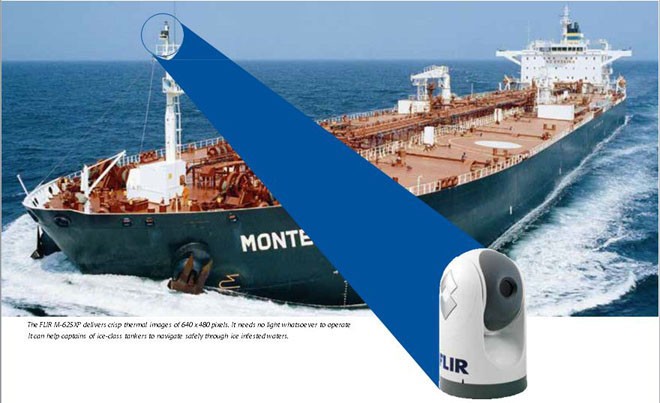Oil tanker thermal imaging in icy waters to help sailors in the future
by FLIR on 26 Oct 2012

Thermal imaging cameras help oil tankers navigate safely through ice infested waters. FLIR
http://www.flir.com/cvs/apac/en/maritime/
Navigating an oil tanker in open water is very challenging. It becomes even more difficult and dangerous when this needs to be done in ice infested waters. Shipping companies are more and more concerned about the safety of ice-class tankers during sub-zero operation and are looking for equipment that can help to detect ice in arctic waters from a far distance so that collisions can be avoided. This growing concern is reinforced by the Oil Companies International Maritime Forum (OCIMF) recommendations. The new thermal imaging solutions are likely to trickle down to cruising and racing sailing fleets.
Based on OCIMF recommendations, TMS Tankers decided therefore to install a FLIR Systems thermal imaging camera on board of two oil tankers that are operating in ice infested waters.
The risks when navigating in ice infested waters today are well known to commercial shipping companies.
The Oil Companies International Marine Forum (OCIMF) formed in April 1970 in response to the growing public concern about marine pollution, particularly by oil, after the Torrey Canyon incident in 1967 is a voluntary association of oil companies with an interest in the shipment and terminalling of crude oil, oil products, petrochemicals and gas. Its mission is to be the foremost authority on the safe and environmentally responsible operation of oil tankers, terminals and offshore support vessels. The OCIMF promotes continuous improvements in design standards and operation.
Late 2010 the OCIMF wrote a recommendation in its 'Ship Inspection Report Program', a standardized inspection report program among members of OCIMF, mentioning the installation of a 'thermal infrared camera' for ice detection on the foremast of ships operating in 'subzero conditions'.
Ice is not always easy to detect in arctic waters. Also not by radar. Smaller pieces are even harder to detect by radar. This is particularly true in heavy sea conditions where the radar returns from ice floes may be lost in the so-called 'sea clutter', which means that the waves show up on the radar image, making it difficult to distinguish between ice and the waves.
During the daylight hours, the inability of radar to detect ice in certain conditions can be compensated by visual inspection.
In the long polar nights this task becomes very difficult due to the lack of light and even during those scarce hours of daylight the visibility might be restricted by fog or snow. In the nighttime, the combination of darkness and fog or snow can limit the capability of regular eyesight to detect ice hazards even further. The searchlight only illuminates objects in the narrow path of its light beam.
A thermal imaging camera presents a much wider view, resulting in better situational awareness.
TMS Tankers is part of Cardiff Marine Inc. and has established a reputation in the international shipping industry for operating and maintaining a fleet with high standards of performance, reliability and safety. It manages a fleet in excess of six million deadweight and is one of the largest Greek based tanker operators.
Based on the recommendations of the OCIMF, TMS Tankers decide to equip two of its vessels that are operating in ice infested waters with a thermal imaging camera.
Prime Ltd., a FLIR distribution partner that operates within the Greek territory, supplied TMS.
TMS Tankers chose for the FLIR M625XP. It is equipped with an un-cooled, maintenance free, Vanadium Oxide (VOx) detector that produces crisp thermal images of 640 x 480 pixels on which the smallest of details can be seen. It needs no light whatsoever to produce crisp images.
Image quality was an important factor but not the only criterion in the purchasing process. TMS Tankers needed to be sure that the thermal imaging cameras would be operating in harsh arctic conditions. The FLIR M625XP operates between 25°C and +55°C. It is also equipped with heating systems that avoids ice growth on the lens. It delivers a sharp, contrasted thermal image even in arctic conditions.
The FLIR M625XP thermal imaging cameras were installed on the bow of the mast of the oil tankers as recommended by OCIMF. This is the highest point where also the navigational lights are installed. Installed in this high position, the FLIR M625XP can overlook a large part of the ocean in front and beside the vessels.
In both cases, the thermal images that are generated by the FLIR M625XP can be seen on a LCD display that is installed on the bridge of the tanker. The thermal images on the screen immediately show the captain and crew if and where there is ice so that they can more safely navigate through ice fields.
The intuitive Joystick Control Unit (JCU) has been integrated in the bridge. The JCU allows for easy access to all the features that are integrated in the FLIR M625XP. It allows for panning the camera 360° continuously and for tilting it.
On both vessels the FLIR M625XP thermal imaging cameras have been mounted in the 'ball down' position.
The FLIR M625XP thermal imaging cameras are very easy to install. The TMS technicians supplied the cameras with power coming from the foremast electricity switchboard. For running video cable from the camera to the LCD on the bridge they took advantage of existing cable ducts.
The Ethernet cable that needs to be connected to the JCU of the FLIR M625XP cameras, was also run though these same cable ducts. No extra power is needed for the JCU since this power is supplied by the FLIR M625XP itself through Power over Ethernet (PoE).
Thanks to FLIR M625XP thermal imaging cameras TMS Tankers vessels will be navigating even safer through arctic waters.
If you want to link to this article then please use this URL: www.sail-world.com/103208